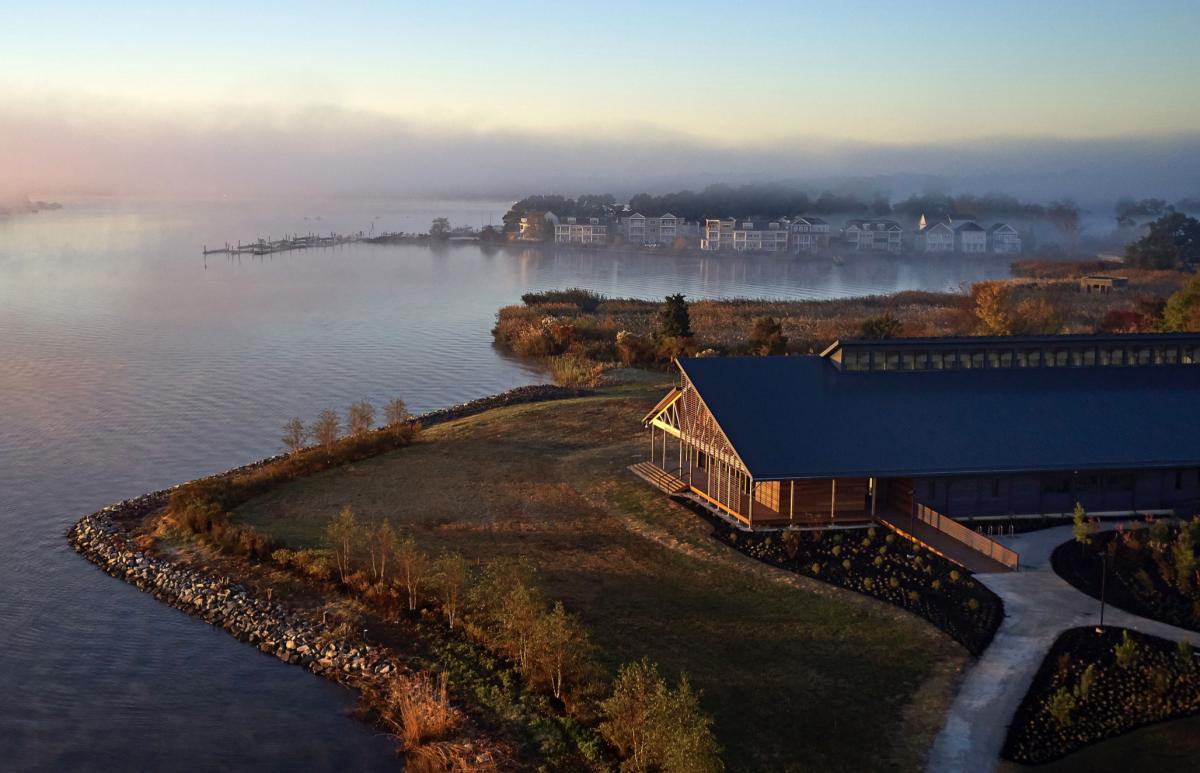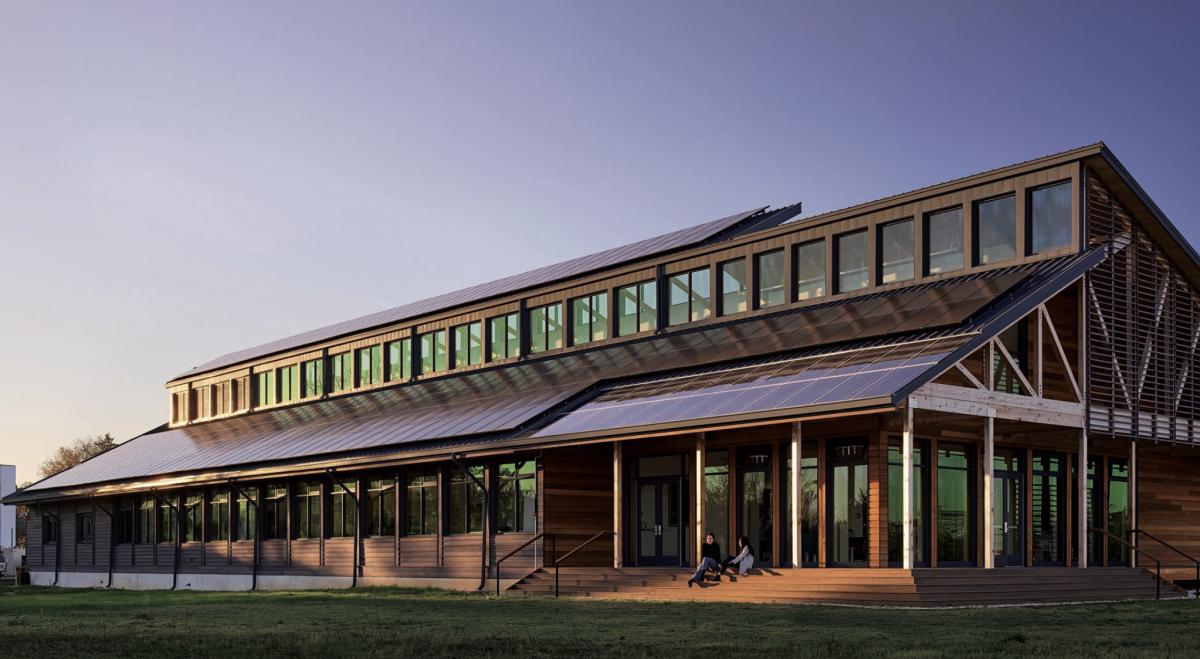 Semans-Griswold Environmental Hall, home of Washington College’s Center for Environment and Society, is up for one of the prestigious Maryland Architecture Excellence in Design Awards this year.
Semans-Griswold Environmental Hall, home of Washington College’s Center for Environment and Society, is up for one of the prestigious Maryland Architecture Excellence in Design Awards this year.
The building commands a picturesque site on the Chester River. The river is physically and programmatically integrated in every aspect of its design. In addition to providing an idyllic setting, the river acts as a living laboratory that affords students with an immersive, hands-on experience in support of the building’s programs in environmental science and wetlands ecology.
 A testament to Washington College’s waterfront renaissance, the net-positive building relies solely on renewable energy sources to operate pollutant-free year-round. Designed to meet the rigorous standards of the Living Building Challenge Petal Certification, Semans-Griswold is expected to produce 105 percent of its energy needs on-site utilizing rooftop photovoltaic panels and a ground-source heating and cooling system.
A testament to Washington College’s waterfront renaissance, the net-positive building relies solely on renewable energy sources to operate pollutant-free year-round. Designed to meet the rigorous standards of the Living Building Challenge Petal Certification, Semans-Griswold is expected to produce 105 percent of its energy needs on-site utilizing rooftop photovoltaic panels and a ground-source heating and cooling system.
The design features clear visual and physical connections to the Chester River which reinforce the work done in the field and in the lab. Inspired by biophilic design, the building celebrates daylight with a rooftop clerestory and connections to the riverfront landscape with ample glazing. A welcoming wrap-around porch with warm wood finishes complements the scale of the building and its natural setting.
The building was designed by Ayers Saint Gross.
The winners will be announced later this year.
Photography provided by Maryland AIA Chapters



H. Robert Yeager AIA (Emer) says
I would like to offer my congratulation to those responsible for the design and construction of Semans-Griswold Environmental Hall, home of Washington College’s Center for Environment and Society, on their nomination for one of the prestigious Maryland Architecture Excellence in Design Awards this year. Who was the Architect?
John L. Seidel says
Thank you for the kind comments, Bob. It is indeed a beautiful building! The architects were Ayers Saint Gross, and the primary contractor was Whiting Turner.
Dale Atkinson says
I really wonder how Washington College was able to build the Environmental Center right on the waterfront with all the concerns of run- off, etc. Was the building’s location approved by Chesapeake Bay Foundation & EPA?
John L. Seidel says
Dale, you have asked a great question! As you might suspect, building in a sensitive area caused great concern for an organization like the Center for Environment & Society, which is committed to improving the quality of our water, air, and habitat. Under normal circumstances, we wouldn’t build so close to the water’s edge, for the reasons you mention and many others. But there are some activities that by their very nature have to be there. That’s certainly the case with a marina, a boathouse, or a building like Semans-Griswold, in which the labs focus on the water and even bring river water directly inside to facilitate research and education.
Knowing that we’d have to be on the water, we did our very best to be responsible about it. First, we spent several million dollars cleaning up the 2 brown fields sites on which it sits, under the oversight of EPA and MDE. This was done to a residential standard we were not required to meet and has prevented a long list of nasty pollutants from getting into the Chester River. Next, we consulted widely, including with partners like the Chesapeake Bay Foundation, who also have had to build on the water and did so successfully. We considered LEED certification and other standards, eventually opting for what we believe to be the most rigorous of the sustainability certifications, the Living Building Challenge. Some of the design details are noted in a project pdf you can download from a link at https://mdaiaawards.secure-platform.com/a/gallery/rounds/49/details/28592?fbclid=IwAR3G_fQz1y77eYUv6ZyF3MmN75ijF5xUd1RMB1AOODedN9NxEbhEkbb7kuo
To note just a few of the features aimed at your concerns, impervious surfaces were minimized on the grounds (especially in parking, paths, etc.). Between the building and the water are native plantings based on our successful native grasslands installed elsewhere in the region. They include a variety of meadows (habitat, pollinator, and foraging) that we don’t have to mow and know from experience filter run-off extremely effectively. The landscaping will sequester 386 tons of carbon a year. The design not only passed the Critical Areas Commission, but review by ShoreRivers and other experts.
As protection against sea level rise and storm surge, we built to a higher elevation than required by code and kept all mechanicals off the first floor. Through a geothermal system and solar panels, the building is net-positive, designed to produce at least 105% of its annual energy needs. In every step of the design and construction, we have been transparent, met or exceeded all code requirements and environmental regulations, and welcome inquiry.
At Washington College, we are extremely proud of this building, the amazing work that goes on inside it, and what it says about our values. We also see it as a wonderful example of how to build in the most responsible way possible, and how the extra cost that entails will be returned many-fold, both in operational savings and in less tangible, but equally important ways.
Thank you for your questions, which are not just reasonable, but very important. Ww’d love to have you visit and see it first-hand!
John L. Seidel says
Want to vote for this amazing, Chestertown building? Cast your ballot at https://mdaiaawards.secure-platform.com/a/gallery/rounds/49/details/28592?fbclid=IwAR3G_fQz1y77eYUv6ZyF3MmN75ijF5xUd1RMB1AOODedN9NxEbhEkbb7kuo
Unlike most elections, you can vote once every 24 hours!